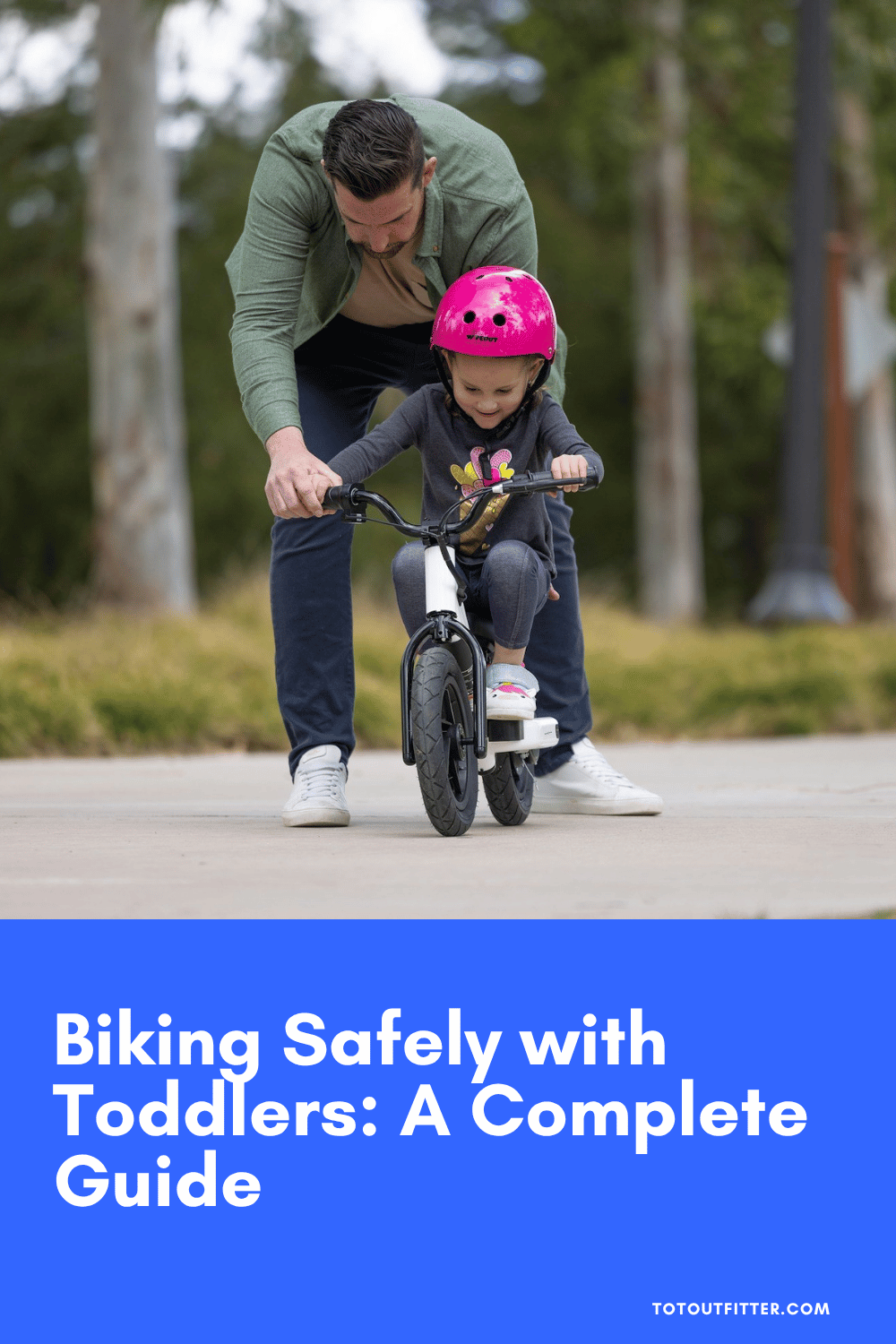Biking Safely with Toddlers: A Complete Guide
Riding bikes with your little ones is a blast, but keeping them safe is a must. Let's dive into the nitty-gritty of biking safety for toddlers – from helmets to navigating the streets and making sure those little hands are protected. Here's your complete guide to making biking a safe and fun adventure for your tots.
Quick Links
Affiliate Disclosure: When you buy through links on our site, we may earn an affiliate commission at no cost to you.
Helmets: The First Line of Defense
The Safety Shield:
Imagine a helmet as your toddler's guardian on their biking journey. Studies show it's super effective in preventing head injuries. So, before each ride, make sure it sits snugly on their noggin.
Proper Helmet Fit:
Use the "two-finger test": when your toddler is wearing the helmet, you should be able to fit two fingers between their eyebrows and the helmet. Only 2 fingers should fit between the strap loop and your toddler’s chin when the helmet is fastened. Be sure the straps are not twisted and that they form a “v” around your child’s ear. If the helmet has a tightener in back, be sure that’s fastened snugly as well. If the helmet still flops around, you may want to find a smaller size.
Age-Appropriate Helmets:
Think of helmets like hats, but cooler. Choose ones specifically designed for toddlers – look for labels like CPSC to ensure they meet safety standards. And hey, let your little one pick their favorite color or a helmet with characters they love.
Positive Helmet-Wearing Experience:
Turn putting on the helmet into a little ritual. Sing a goofy song, maybe do a wiggle dance – make it fun! This positive vibe will help your toddler see it as a cool routine, not just a safety measure.
Creating Helmet Habits:
To build a consistent helmet-wearing habit, make it part of your routine. Create a little checklist that your toddler can participate in – did we remember the helmet today? A sticker chart can be a fun visual tracker for their superhero helmet moments.
Exploring Helmet Styles:
Transform helmet selection into a mini-adventure. Explore different styles and colors. Perhaps there's a helmet with their favorite animal or cartoon character. This involvement makes them more likely to embrace their safety gear.
Emphasizing Helmet Ownership:
Encourage your toddler to take ownership of their helmet. Let them carry it to the bike, put it on themselves (with your double-check), and eventually, store it properly after the ride. This sense of responsibility fosters a positive association with helmet use.
Addressing Helmet Concerns:
If your toddler expresses discomfort or reluctance, address their concerns. Ensure the straps aren't too tight, the helmet sits comfortably, and talk about the helmet's role in keeping them safe. It's about making them feel secure, not restricted.
Safe Rides: Navigating the Streets
Choosing the Right Bike:
Picking a bike is like choosing a new toy. Look for one that's low to the ground with wide tires. Training wheels? They're like little helpers for your tot until they get the hang of things. Try starting with a balance bike as well for the youngest riders or if your child isn’t quite ready for pedals.
Adjusting for Comfort:
Comfort is key! Adjust the seat and handlebars so your toddler can easily reach them. And don't forget to add some flair – a basket or streamers can make their ride uniquely theirs.
Supervision and Boundaries:
Keep a close eye on your little rider. Set clear rules about where they can go – sticking to the sidewalk is a great start. Plan routes away from busy streets, and maybe explore local parks or bike paths.
Teaching Basic Riding Skills:
Think of it as teaching a mini-driving course. Create a pretend road on the sidewalk using chalk. Practice stopping at stop signs (maybe use a stuffed animal as a traffic cop) and making turns. It's like a little biking game!
Supervised Solo Rides:
Solo rides are like a rite of passage, but until then, keep it supervised. Create a safe space for them to practice, like a backyard obstacle course. It's a mini adventure under your watchful eye.
Transitioning to Real Streets:
Gradually introduce your toddler to real streets as their skills improve. Start with quiet, less-trafficked areas before venturing into busier places. Make it a progression, ensuring they feel confident at each stage.
Setting and Reinforcing Boundaries:
Establish clear biking boundaries – where they can ride and where they should avoid. Regularly reinforce these boundaries during rides and discuss why certain areas are off-limits. It's about creating a safe biking zone.
Choosing Safer Routes:
When planning biking adventures, choose routes with minimal traffic. Opt for scenic paths, parks, or residential streets. Familiarize yourself with local bike paths, ensuring they provide a secure environment for your toddler.
Road Rules for Toddlers: Building a Foundation
Introduction to Road Safety:
Turn road safety into a game. Use toy cars and traffic signs to create a mini-traffic school at home. It's like having your own traffic adventure without leaving the driveway.
Recognizing Traffic Signals and Signs:
Make learning fun by going on a scavenger hunt for traffic signs in your neighborhood. Play "Red Light, Green Light" to understand traffic signals. It's like turning road rules into a cool adventure.
Stopping at Intersections:
Play traffic cop with your toddler. Practice stopping at imaginary intersections and looking both ways. Hand gestures add a fun element to learning about safety.
Hand Signals and Communication:
Imagine you and your toddler are biking explorers. Teach hand signals for turns and stops – it's like creating secret biking codes. Communication is key, even for little riders.
Use of Designated Bike Paths and Lanes:
Explore parks with dedicated bike paths. Teach your toddler about staying in special bike lanes. It's like having your own bike highway – safe and free for exploration.
Creating Mini Road Courses:
Enhance road rule learning by creating mini road courses at home or in an open space. Use cones or chalk to outline "streets" and "intersections." Practice stopping, turning, and following traffic rules in this controlled environment.
Common Mistakes to Avoid
Not Being Consistent With Helmet Use:
Make helmet time a routine. Create a checklist together – did we remember the helmet? A sticker chart can be a fun way to track their superhero helmet moments.
Not Supervising Every Ride:
Solo rides are like a badge of honor, but until then, keep it supervised. Create a safe space for them to practice, like a backyard obstacle course. It's a mini adventure under your watchful eye.
Not Teaching Basic Road Rules:
Turn road rule lessons into storytelling. Create characters and scenarios – maybe Mr. Stop Sign is their biking buddy. Keep it light, keep it fun.
Not Choosing the Right Bike:
Let your toddler be the bike picker. Take them to the store, let them test a few options, and encourage them to choose the one that feels just right. Ownership leads to responsibility.
Not Having Realistic Riding Expectations:
Every small victory deserves a celebration. Did they stop smoothly? Did they turn without wobbling? Praise those moments. Positive vibes build confidence and safer riding skills.
Transition to Real Streets Too Quickly:
Don't rush into busy streets. Gradually introduce your toddler to real streets as their skills improve. Start with quieter, less-trafficked areas before venturing into busier places.
Not Consistently Reinforcing Boundaries:
Establishing biking boundaries is important, but reinforcing them consistently is crucial. Regularly discuss and remind your toddler about where they can and cannot ride.
Not Planning Routes Ahead of Time:
When planning biking adventures, prioritize safety in route selection. Choose paths away from heavy traffic, ensuring a stress-free and secure environment for your toddler.
Safety Gear: Beyond Helmets
Importance of Additional Safety Gear:
Besides helmets, knee pads and gloves act as extra layers of protection. Think of them like a bike's cozy blanket – providing comfort and safety.
Choosing and Fitting Knee Pads:
Knee pads should fit securely without cramping their style. Velcro straps are like magic – easy to put on and take off. Let your toddler try them on and adjust the straps for that perfect fit.
Benefits of Gloves:
Gloves aren't just for show – they're like cozy hand-hugs for the handlebars. Look for padded palms for extra comfort. Gloves make biking both safe and stylish.
Making Safety Gear Fun:
Turn gear-wearing into a little fashion show. Let your toddler pick knee pads and gloves with their favorite colors or characters. Stickers can add a personal touch – safety with a splash of style!
Regular Safety Gear Check:
Make safety gear checks a routine before each ride. Ensure that helmets, knee pads, and gloves are in good condition and fit properly. Consistency in gear maintenance reinforces the importance of safety.
Encouraging Independence in Gear Use:
As your toddler grows, encourage them to take charge of putting on their safety gear. It's a step towards independence and responsibility. Provide assistance when needed, fostering a sense of accomplishment.
Encouraging a Lifelong Love for Safe Cycling
Fun Educational Activities:
Turn safety into playtime. Create a "bike safety scavenger hunt" – find the safe biking practices! It's like a treasure hunt, but for biking knowledge.
Family Bike Adventures:
Make family rides a big deal. Pack a picnic, explore local trails – turn it into a weekend tradition. It's not just biking; it's creating lasting family memories.
Celebrate Milestones:
Every achievement, big or small, deserves a cheer. Create a "Bike Achievement Wall" – a gallery of biking milestones. It's like building a superhero wall of victories.
Ongoing Safety Conversations:
As your toddler grows, your safety talks evolve. Discuss recent rides, highlight the good stuff, and address any concerns. It's like having a biking chat – keeping it a constant part of their growing experience.
Adapting Conversations to Growth:
Adapt safety conversations to your toddler's understanding as they grow. Discuss recent rides, emphasizing positive aspects and addressing any concerns. Maintaining an open dialogue ensures continuous awareness of safety.
Building Positive Associations:
Make bike safety a part of positive experiences. Connect safety talks with enjoyable activities, creating a positive association. This approach fosters a lifelong love for safe biking.
Wrapping it up, ensuring a safe biking experience for toddlers is a journey filled with fun, learning, and celebration. From helmets to road rules and funky gear, make biking secure and memorable. So, gear up, hop on those bikes, and let the biking adventure begin!
Disclaimer: The information presented is purely to share our experience and for entertainment purposes. Tot Outfitters assumes no legal liability for the accuracy, completeness, or usefulness of any information, apparatus, product or process disclosed on this website or linked to this website. The author and Tot Outfitters disclaim liability for any damage, mishap, or injury that may occur from engaging in any activities or ideas from this site.




